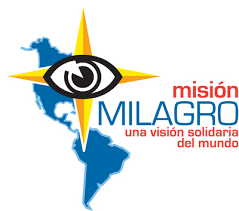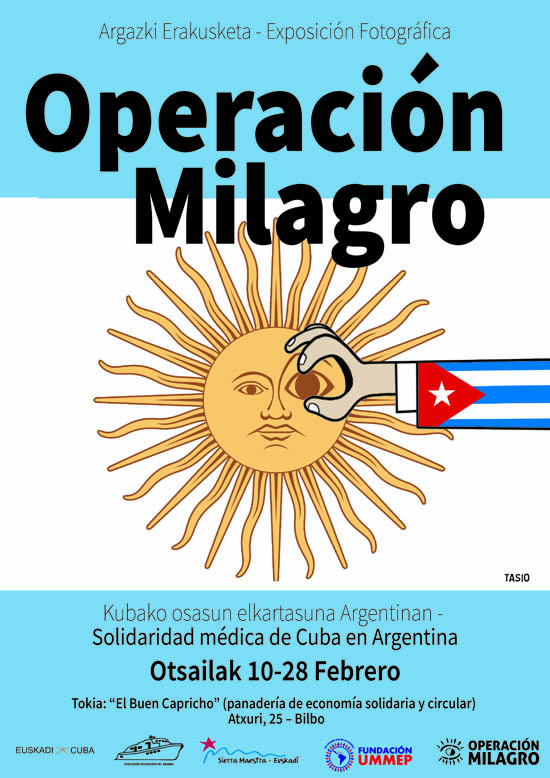More languages
More actions
No edit summary Tag: Visual edit |
No edit summary Tag: Visual edit |
||
| (One intermediate revision by the same user not shown) | |||
| Line 1: | Line 1: | ||
'''Operación Milagro''' (English: ''Operation Miracle''; also ''Misión Milagro'' in [[Bolivarian Republic of Venezuela|Venezuela]]) is a | [[File:Mision-milagro.png|thumb|Logo]] | ||
'''Operación Milagro''' (English: '''''Operation Miracle'''''; also '''''Misión Milagro''''' in [[Bolivarian Republic of Venezuela|Venezuela]]) is a program of international solidarity launched in 2004 by the governments of [[Cuba]] and Venezuela to provide free medical treatment for poor people with eye problems in the [[Global South]], primarily in [[Iberoamerica|Latin America]].<ref>[http://www.cubadebate.cu/noticias/2014/07/01/mas-de-tres-millones-de-beneficiados-con-operacion-milagro-en-diez-anos/ "Más de tres millones de beneficiados con Operación Milagro en diez años"]. Cubadebate.</ref> It additionally provides the countries it operates in with new medical equipment and infrastructure.<ref>Kirk, John M. (2015). Healthcare without Borders: Understanding Cuban Medical Internationalism. Gainesville: University Press of Florida. pp. 96–117.</ref> By 2019, over 4 million people in 34 countries had received free treatment through the program.<ref>Yaffe, Helen (2020). [https://www.worldcat.org/title/1139710255 We are Cuba!: how a revolutionary people have survived in a post-Soviet world.] New Haven: Yale University Press. p. 164. ISBN 978-0-300-24551-6. OCLC 1139710255.</ref> The program is integrated into the programs of the [[ALBA]].<ref name="Lamrani">Lamrani, Salim. “THE BOUVARIAN ALLIANCE FOR THE PEOPLES OF OUR AMERICA: THE CHALLENGES OF SOCIAL INTEGRATION.” ''International Journal of Cuban Studies'' 4, no. 3/4 (2012): 347–65.</ref> | |||
While in the initial phase of the program patients were | While in the initial phase of the program, patients were flown to [[Havana]], Cuba to be attended there, by 2017 there were 69 [[ophthalmological]] centers in 15 countries, carrying out vision-saving and restoring surgery.<ref name="Yaffe">Yaffe, Helen. “Cuban Medical Internationalism: An Army of White Coats.” In ''We Are Cuba!: How a Revolutionary People Have Survived in a Post-Soviet World'', 147–74. Yale University Press, 2020.</ref> The initial phases of the program only served people in Cuba and Venezuela in 2004–05, but by 2006, the program began to include other countries in Latin America and [[Africa]]. | ||
In 2006, [[Ernesto Guevara|Che Guevara]]'s own killer, [[Mario Terán]], had his eyesight treated and cataracts removed in Cuba as part of this program.<ref>[https://www.theguardian.com/world/2007/oct/02/cuba.international] ''Cuban doctors restore sight of Che's killer'' 2 October 2007. ''The Guardian''</ref> | In 2006, [[Ernesto Guevara|Che Guevara]]'s own killer, [[Mario Terán]], had his eyesight treated and cataracts removed in Cuba as part of this program.<ref>[https://www.theguardian.com/world/2007/oct/02/cuba.international] ''Cuban doctors restore sight of Che's killer'' 2 October 2007. ''The Guardian''</ref> | ||
==Origins== | ==Origins and accomplishments== | ||
[[File:Euskadi Cuba argazki Mesa de tra - Copy 1.jpg|thumb|A poster about a photographic exposition of Operation Miracle's services in [[Argentine Republic|Argentina]].]] | |||
Vision impairment is a greater issue in the [[Global South]], as in 2015 ninety percent of all [[visually impaired]] people lived in the developing world. Latin America specifically struggles with a lack of access to healthcare and malnourishment, directly affecting the eyesight of millions in the region.<ref name="Public Health in Latin America">"Public Health in Latin America." In ''An Atlas and Survey of Latin American History'', by Michael LaRosa, and German R. Mejia. 2nd ed. Routledge, 2019.</ref> Eye surgeries can cost upwards of $10,000 in medical costs.<ref name="Lamrani" /> Issues regarding poor medical systems has led to many of the twentieth century Latin American revolutions addressing gaps in medicine.<ref name="Public Health in Latin America" /> Since the [[Cuban Revolution]], the government in Cuba has committed itself to advances in healthcare.<ref name="Public Health in Latin America" /> This includes internationalist missions to Latin America and Africa, which have been an aspect of Cuba’s foreign policy and relationship to the Global South during the twentieth century.<ref name="Blue">Blue, Sarah A. “Cuban Medical Internationalism: Domestic and International Impacts.” ''Journal of Latin American Geography'' 9, no. 1 (2010): 31–49.</ref> | Vision impairment is a greater issue in the [[Global South]], as in 2015 ninety percent of all [[visually impaired]] people lived in the developing world. Latin America specifically struggles with a lack of access to healthcare and malnourishment, directly affecting the eyesight of millions in the region.<ref name="Public Health in Latin America">"Public Health in Latin America." In ''An Atlas and Survey of Latin American History'', by Michael LaRosa, and German R. Mejia. 2nd ed. Routledge, 2019.</ref> Eye surgeries can cost upwards of $10,000 in medical costs.<ref name="Lamrani" /> Issues regarding poor medical systems has led to many of the twentieth century Latin American revolutions addressing gaps in medicine.<ref name="Public Health in Latin America" /> Since the [[Cuban Revolution]], the government in Cuba has committed itself to advances in healthcare.<ref name="Public Health in Latin America" /> This includes internationalist missions to Latin America and Africa, which have been an aspect of Cuba’s foreign policy and relationship to the Global South during the twentieth century.<ref name="Blue">Blue, Sarah A. “Cuban Medical Internationalism: Domestic and International Impacts.” ''Journal of Latin American Geography'' 9, no. 1 (2010): 31–49.</ref> | ||
In the post-Soviet world, [[Cuban medical internationalism]] has greatly expanded for both political recognition and economic incentive.<ref name="Blue" /> After [[Hugo Chávez]] became the [[President of Venezuela]] in 1998, Cuba and Venezuela began an organization in 2003 called the ALBA, economically and politically connecting [[Left-wing politics|left-wing]] Latin American governments.<ref name="Lamrani" /> To combat illiteracy, the two governments created an initiative called “[[Yo, si puedo|Yo, sí puedo]],” or “Yes, I can.”<ref>Salim Lamrani, and Translated by Larry R. Oberg. “Fidel Castro, Hero of the Disinherited.” ''International Journal of Cuban Studies'' 8, no. 2 (2016): 151–68.</ref> However, the program reached a roadblock, as poor vision from a lack access to healthcare in Latin America hampered the ability to read. In 2004, the Cuban and Venezuelan governments then reached an agreement to create a new program to combat the issue of poor vision and blindness, known as ''Operación Milagro'', or Operation Miracle. | In the post-Soviet world, [[Cuban medical internationalism]] has greatly expanded for both political recognition and economic incentive.<ref name="Blue" /> After [[Hugo Chávez]] became the [[President of Venezuela]] in 1998, Cuba and Venezuela began an organization in 2003 called the ALBA, economically and politically connecting [[Left-wing politics|left-wing]] Latin American governments.<ref name="Lamrani" /> To combat illiteracy, the two governments created an initiative called “[[Yo, si puedo|Yo, sí puedo]],” or “Yes, I can.”<ref>Salim Lamrani, and Translated by Larry R. Oberg. “Fidel Castro, Hero of the Disinherited.” ''International Journal of Cuban Studies'' 8, no. 2 (2016): 151–68.</ref> However, the program reached a roadblock, as poor vision from a lack access to healthcare in Latin America hampered the ability to read. In 2004, the Cuban and Venezuelan governments then reached an agreement to create a new program to combat the issue of poor vision and blindness, known as ''Operación Milagro'', or Operation Miracle. | ||
The impact of Operacion Milagro has been tremendous, as millions in Latin America, Africa, and [[Asia]] have received surgeries and treatment for eye problems like cataracts, pterygium, strabismus, glaucoma, and other ocular conditions. Countries in the scope of the program include Cuba, Venezuela, [[Oriental Republic of Uruguay|Uruguay]], [[Plurinational State of Bolivia|Bolivia]], [[Republic of Guatemala|Guatemala]], [[Republic of El Salvador|El Salvador]], [[Republic of Angola|Angola]], [[Republic of Panama|Panama]], [[Republic of Nicaragua|Nicaragua]], and [[Republic of Ecuador|Ecuador]], among many others. Among the patients of the program was Mario Terán, the Bolivian man who executed Che Guevara. Overall, by 2019, over four million people in 34 countries had been cured of their ailments. | |||
== References == | == References == | ||
{{Reflist}} | {{Reflist}} | ||
Revision as of 05:14, 3 September 2023

Operación Milagro (English: Operation Miracle; also Misión Milagro in Venezuela) is a program of international solidarity launched in 2004 by the governments of Cuba and Venezuela to provide free medical treatment for poor people with eye problems in the Global South, primarily in Latin America.[1] It additionally provides the countries it operates in with new medical equipment and infrastructure.[2] By 2019, over 4 million people in 34 countries had received free treatment through the program.[3] The program is integrated into the programs of the ALBA.[4]
While in the initial phase of the program, patients were flown to Havana, Cuba to be attended there, by 2017 there were 69 ophthalmological centers in 15 countries, carrying out vision-saving and restoring surgery.[5] The initial phases of the program only served people in Cuba and Venezuela in 2004–05, but by 2006, the program began to include other countries in Latin America and Africa.
In 2006, Che Guevara's own killer, Mario Terán, had his eyesight treated and cataracts removed in Cuba as part of this program.[6]
Origins and accomplishments

Vision impairment is a greater issue in the Global South, as in 2015 ninety percent of all visually impaired people lived in the developing world. Latin America specifically struggles with a lack of access to healthcare and malnourishment, directly affecting the eyesight of millions in the region.[7] Eye surgeries can cost upwards of $10,000 in medical costs.[4] Issues regarding poor medical systems has led to many of the twentieth century Latin American revolutions addressing gaps in medicine.[7] Since the Cuban Revolution, the government in Cuba has committed itself to advances in healthcare.[7] This includes internationalist missions to Latin America and Africa, which have been an aspect of Cuba’s foreign policy and relationship to the Global South during the twentieth century.[8]
In the post-Soviet world, Cuban medical internationalism has greatly expanded for both political recognition and economic incentive.[8] After Hugo Chávez became the President of Venezuela in 1998, Cuba and Venezuela began an organization in 2003 called the ALBA, economically and politically connecting left-wing Latin American governments.[4] To combat illiteracy, the two governments created an initiative called “Yo, sí puedo,” or “Yes, I can.”[9] However, the program reached a roadblock, as poor vision from a lack access to healthcare in Latin America hampered the ability to read. In 2004, the Cuban and Venezuelan governments then reached an agreement to create a new program to combat the issue of poor vision and blindness, known as Operación Milagro, or Operation Miracle.
The impact of Operacion Milagro has been tremendous, as millions in Latin America, Africa, and Asia have received surgeries and treatment for eye problems like cataracts, pterygium, strabismus, glaucoma, and other ocular conditions. Countries in the scope of the program include Cuba, Venezuela, Uruguay, Bolivia, Guatemala, El Salvador, Angola, Panama, Nicaragua, and Ecuador, among many others. Among the patients of the program was Mario Terán, the Bolivian man who executed Che Guevara. Overall, by 2019, over four million people in 34 countries had been cured of their ailments.
References
- ↑ "Más de tres millones de beneficiados con Operación Milagro en diez años". Cubadebate.
- ↑ Kirk, John M. (2015). Healthcare without Borders: Understanding Cuban Medical Internationalism. Gainesville: University Press of Florida. pp. 96–117.
- ↑ Yaffe, Helen (2020). We are Cuba!: how a revolutionary people have survived in a post-Soviet world. New Haven: Yale University Press. p. 164. ISBN 978-0-300-24551-6. OCLC 1139710255.
- ↑ 4.0 4.1 4.2 Lamrani, Salim. “THE BOUVARIAN ALLIANCE FOR THE PEOPLES OF OUR AMERICA: THE CHALLENGES OF SOCIAL INTEGRATION.” International Journal of Cuban Studies 4, no. 3/4 (2012): 347–65.
- ↑ Yaffe, Helen. “Cuban Medical Internationalism: An Army of White Coats.” In We Are Cuba!: How a Revolutionary People Have Survived in a Post-Soviet World, 147–74. Yale University Press, 2020.
- ↑ [1] Cuban doctors restore sight of Che's killer 2 October 2007. The Guardian
- ↑ 7.0 7.1 7.2 "Public Health in Latin America." In An Atlas and Survey of Latin American History, by Michael LaRosa, and German R. Mejia. 2nd ed. Routledge, 2019.
- ↑ 8.0 8.1 Blue, Sarah A. “Cuban Medical Internationalism: Domestic and International Impacts.” Journal of Latin American Geography 9, no. 1 (2010): 31–49.
- ↑ Salim Lamrani, and Translated by Larry R. Oberg. “Fidel Castro, Hero of the Disinherited.” International Journal of Cuban Studies 8, no. 2 (2016): 151–68.
